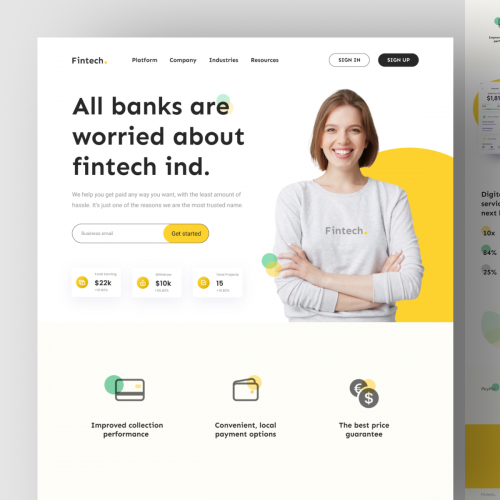User-Friendly Website Design Services That Improve Usability and User Experience
User-Friendly Website Design Services That Improve Usability and User Experience
Blog Article
Leading Tips for Producing an Impactful Web Site Layout That Transforms
To accomplish this, one should think about a range of elements, consisting of understanding the target audience, focusing on user experience, and maximizing for mobile platforms. The strategic usage of engaging call-to-actions and a well-defined aesthetic hierarchy plays a critical duty in assisting customers through their trip.

Understand Your Target Market
Comprehending your target audience is basic to effective web site design, as it prepares for creating an engaging customer experience. Determining that your users are, including their demographics, preferences, and actions, allows designers to tailor the website's web content, format, and functionality to satisfy specific requirements.
Conducting extensive marketing research is essential in this procedure. Surveys, meetings, and analytics can give important understandings into customer assumptions and pain points. By assembling this data, designers can create customer personas that represent various segments of the target market, ensuring that style choices are educated and relevant.
In addition, recognizing the target audience helps in choosing ideal layout elements such as color plans, typography, and imagery that resonate with customers. An internet site that speaks directly to its target market fosters a sense of link and depend on, urging longer check outs and greater conversion rates.
Eventually, a user-centered technique to internet site layout not only improves individual contentment but additionally sustains business objectives by driving engagement and loyalty. By focusing on the demands and choices of the target market, a website can properly offer its objective and attain wanted results.
Prioritize Individual Experience
To improve the general efficiency of a site, prioritizing individual experience (UX) is crucial (Website Design). A properly designed UX makes sure that site visitors can browse the site effortlessly, discover info rapidly, and engage with content meaningfully. This brings about boosted individual fulfillment and higher conversion prices
Begin by carrying out user-friendly navigation. Menus needs to be practically structured, allowing users to situate crucial areas of the site with minimal initiative. Uniformity in design components, such as color design and font styles, fosters familiarity, which is important for preserving user involvement.
In addition, consider the filling speed of your website. A hold-up of simply a couple of seconds can bring about significant drop-offs, as users are less most likely to wait on a slow-loading web page. Improving pictures and optimizing code can boost performance and preserve site visitors.
Additionally, clarity in content discussion is essential. Use concise, appealing language and separate message with visuals to boost readability. By prioritizing individual experience, you not just create an extra pleasurable atmosphere for site visitors yet additionally strengthen your brand's integrity. Inevitably, a concentrate on UX is a financial investment in the long-lasting success of your internet site.
Maximize for Mobile Instruments
Optimizing for mobile devices is critical in today's electronic landscape, where an increasing variety of individuals access sites through smartphones and tablet computers. A mobile-friendly style not only enhances user experience but additionally plays a significant role in improving online search engine positions. To accomplish this, it is crucial to take on a receptive style that instantly adjusts to numerous display sizes and positionings.

Filling rate is another critical aspect; mobile individuals are typically much less individual and expect quick access to details. Enhance images additional resources and leverage web browser caching to boost efficiency. Ultimately, test your web site on multiple tools and screen resolutions to recognize and correct any type of potential usability concerns. By prioritizing mobile optimization, you make sure that your website continues to be affordable and efficiently involves a broader audience.
Use Engaging Call-to-Actions
A website's efficiency usually visit this website hinges on its capacity to assist site visitors towards wanted actions, making compelling call-to-actions (CTAs) essential elements of layout. CTAs work as the crucial points that guide customers to involve with the site, whether that means making an acquisition, registering for a newsletter, or downloading a resource.
To create efficient CTAs, clarity is paramount. Use succinct language that plainly communicates the action you want the customer to take.
In addition, the design of CTAs should stand out without being interfering. Utilize contrasting colors and clear typefaces to ensure they capture focus. Furthermore, take into consideration using directional signs, such as arrows or photos, to lead users towards these buttons. By focusing on these aspects, businesses can substantially improve user interaction, driving conversions and inevitably achieving their web site's goals.
Emphasis on Visual Power Structure
Effective web site design counts link greatly on a well-structured visual pecking order that guides customers through content seamlessly. By arranging components in a fashion that focuses on info, developers can boost customer experience and facilitate decision-making. This includes making use of size, color, comparison, and spacing purposefully to accentuate one of the most vital parts of a page.
The usage of bigger fonts for headings and subheadings establishes a clear difference between various areas, allowing individuals to check material effortlessly. Furthermore, utilizing different colors for switches and calls-to-action can record customer attention and motivate communication. Whitespace is one more crucial component; it avoids clutter and allows users to concentrate on essential messages without diversions.
Photos and graphics need to enhance the text while also adhering to the recognized power structure, reinforcing the overall message (Website Design). Consistency in design components, such as shade systems and typography, more reinforces the visual hierarchy, making navigating instinctive

Conclusion
In conclusion, effective site layout requires a comprehensive understanding of the target audience, prioritization of individual experience, and mobile optimization. Inevitably, a well-executed website design offers as a crucial component in driving user activities and attaining company goals.
Report this page